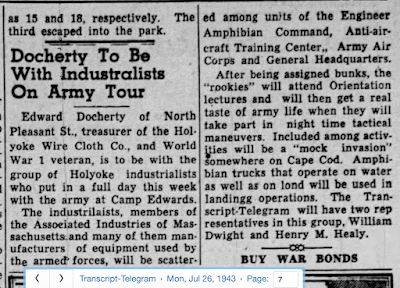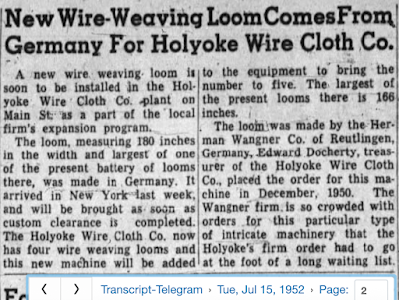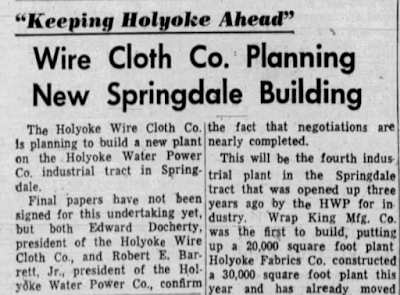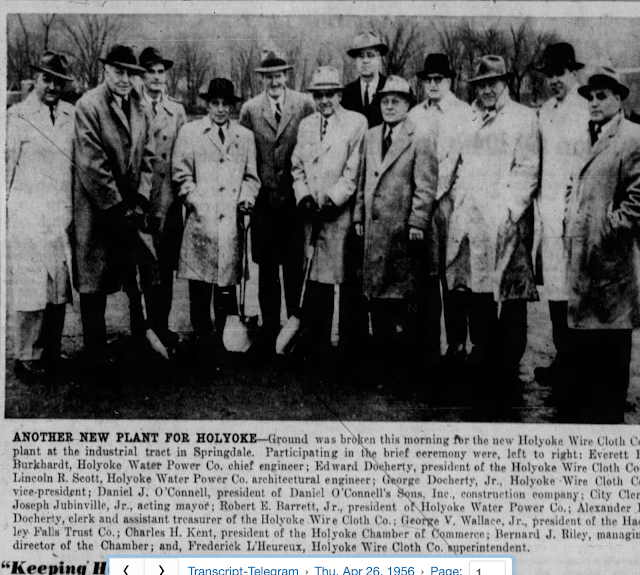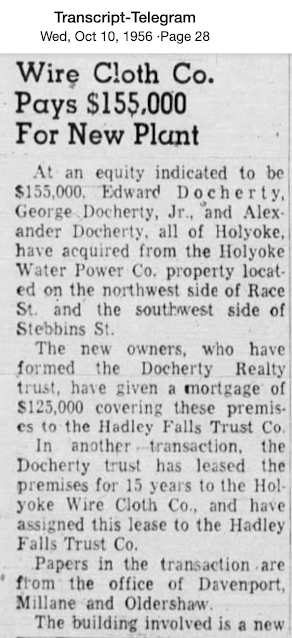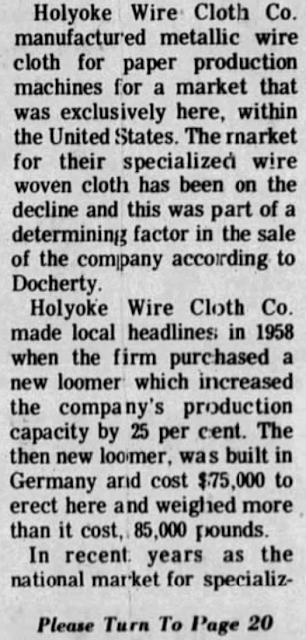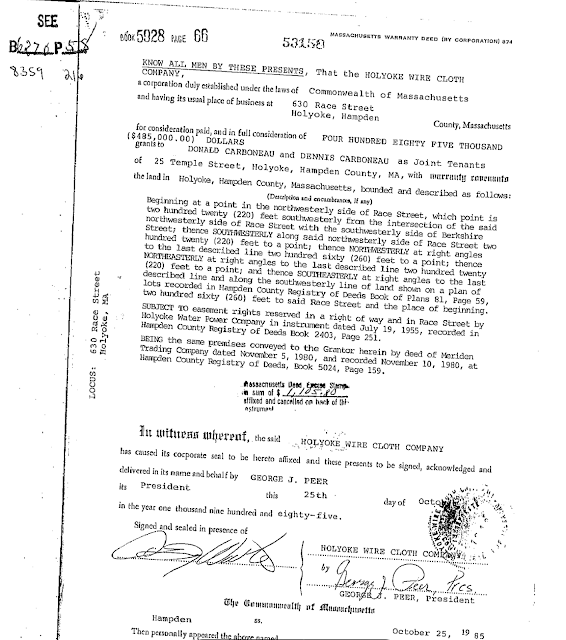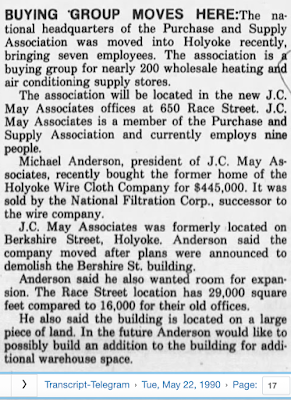There were more mill operations than I had previously thought in the area of I-391 stretching from High and Maple Streets to the Connecticut River. Another long-time business was the Holyoke Wire Cloth Company.
When the Beebe & Webber Company ceased operations in 1914, the plant was subsequently sold to Jesse Sheldon. George Docherty Sr., a long-time employee of Buchanan & Bolt Company and resident of 69 Brown Avenue, decided to start his own business. He incorporated the Holyoke Wire Cloth Company, and its business would be located in the southern portion of the former Beebe & Webber plant complex at 649 Main Street. Mr. Docherty was President of the corporation, and John Warner of Springfield was named Treasurer.
Mr. Docherty had extensive experience in the wire-making business. Born in 1862, he hailed from Glasgow. Scotland. He had worked in and eventually owned a wire-making company, which he later sold to fund his move to the United States. Upon arrival in 1895, he worked at Buchanan & Bolt for fifteen years and at Cheney Bigelow in Springfield. He left the latter to start the Holyoke Wire Cloth Company.
The company was a manufacturer of Fourdrinier wire, a cloth wire used in papermaking machinery. By 1932, the business had experienced its most successful year to date. The company imported a Fourdrinier weaving machine from Germany, capable of weaving cloth wire with a width of 166 inches. The machine was the largest of its kind in the city.
Having started with two hand looms in 1919, the company had progressed by 1934 to seven modern machines of high design and quality.
By 1935, George Docherty Sr. was joined by his three sons, George Jr., Alexander, and Edward, in operating the business. Two were experienced weavers, and, including their grandfather, they had a combined 113 years of continuous experience in wire weaving. The third son was now the Treasurer of the business.
Additionally, in 1935, Lafrance Construction constructed an 85-by-35-foot plant addition. This was to provide room for additional looms.
The business was not immune to problems. There were lockouts by employees seeking the restoration of prior wage cuts or pay increases. A local trade council's support for a congressional bill advocating a 30-hour workweek was opposed by employees.
A ban on Fourdinier copper wire was imposed in 1942 during the war years, but it was reversed due to the necessity of maintaining stable production in the paper industry. In 1946, the Eagle Lodge of Papermakers instituted a ban on the handling of non-union-produced Fourdrinier wire. This impacted local sales of Holyoke Wire Cloth Co.'s products. The ban was lifted in 1948.
In 1952, a 180-inch loom was ordered from a German manufacturing company. It was the largest loom in the area.
Technology was changing, as was the space necessary to accommodate the latest equipment. The trend in new factories was one-story buildings with a larger footprint. This could not be accomplished in the company's present setting on Main Street. In the 1950s, the new Springdale Industrial Park land, made available for sale by the Holyoke Water Power Company, provided the company with the land it needed.
On November 11, 1955, George Docherty Sr. died. He was the President of the business until his retirement in 1953 at the age of 91.
In mid-1955, a 250-inch wire weaving loom and a stretching table were specially ordered from a German manufacturer for $75,000. It was due for delivery in mid-1956. The company needed new quarters for expansion and to accommodate the open concept required for such new and innovative equipment. A decision was reached to build in the industrial park. A $155,000 building was erected at 650 Race Street, at the corner of Stebbins Street.
In late October or early November 1956, the new plant began operating. This mill had 24,000 square feet of space, compared to 7,800 square feet at its former site.
In 1958, a 260-inch loom was purchased from the Hermann Wangner Company in Reutlingen, Germany, the same company that had produced and shipped prior orders. An engineer flew in from Germany to supervise the installation, which was expected to take a month. The machine weighed 85,000 pounds, and a rigging company from Hartford, CT, was hired to install it.
A one-story addition to the manufacturing plant was built in 1964, and an office space addition was constructed two years later.
Drastic changes began to occur, which would alter the Docherty family and the business. All three of George Docherty's sons died within two years from 1969 to 1971. Richard McKay, who joined the company in 1948 and became President of the corporation in 1971, died in 1973.
The Holyoke Wire Cloth Company was sold to Connecticut Valley Holding Company in December 1973, mostly ending the Docherty family's corporate interest. Another sale occurred in 1975, when the business was sold to Multi-Metal Wire Cloth Inc. of Tappan, New York. The demand for cloth wire had significantly diminished, and the new owners were altering the product line.
In 1980, the new company sought and received a $980,000 industrial development bond to purchase the neighboring one-story mill at 630 Race Street, with the remainder of $360,000 to purchase the equipment of Holyoke Wire Cloth Company and additional new equipment. The latest business, United-Holyoke Corporation, was a joint venture of Holyoke Wire Cloth and United Wire Group, Ltd., of Edinburgh, Scotland.
In 1985, Holyoke Wire Cloth sold the real estate at 630 Race Street that it had acquired five years prior.
In 1988, Holyoke Wire Cloth was acquired by Pascale Corp., an Arkansas corporation. The new company absorbed Holyoke Wire Cloth into its corporation. Various attempts have failed to determine whether the company or its name is still in use.
In 1990, Holyoke Wire Cloth Company's former business location at 650 Race Street was sold by National Filtration Co., the successor to Holyoke Wire Cloth, to J. C. May Corporation. The new company moved quickly on this purchase, after hearing plans that the building was to be demolished. J. C. May Corp. was part of a buying association for over 200 wholesale refrigeration and heating supply stores.
































